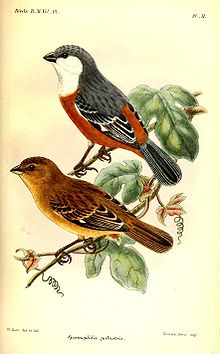- Marsh Seedeater
-
Marsh Seedeater 
Male Conservation status Scientific classification Kingdom: Animalia Phylum: Chordata Class: Aves Order: Passeriformes Family: Thraupidae Genus: Sporophila Species: S. palustris Binomial name Sporophila palustris
(Barrows, 1883)The Marsh Seedeater (Sporophila palustris) is a species of bird in the Thraupidae family. It is sexually dichromic, with the males sporting a bright white throat, grey crown and chestnut belly, and the females resembling other brown female seedeaters.
It is found in Argentina, Brazil, Paraguay, and Uruguay. It is migratory, breeding in wet grasslands and marshes around Uruguay and Argentina and migrating northwards in the austral winter to wet and dry grasslands in southern Brazil.
It is threatened by habitat loss, trapping for the pet trade, and pesticides. It is currently protected across most of its range and several protected areas may help safeguard this species.
The Entre Ríos Seedeater
A rare seedeater very similar to this species breeds in the Entre Ríos province of Argentina,[1] and a few individuals have been found in Corrientes province and in southern Brazil, eastern Paraguay, and southeastern Uruguay.[2] It has been listed as a separate species, Sporophila zelichi (Narosky 1977), the Entre Ríos, White-collared, Zelich's, or Narosky's Seedeater. Differences are that it has a wide white collar all the way around the neck; the back is chestnut, not grey; and the rufous of the belly is darker than the Marsh Seedeater's. However, its status has been controversial since its discovery; some have suggested that it is a color morph of the Marsh Seedeater or the Chestnut Seedeater, or a hybrid between the two. The few recorded songs are the same as those of the Marsh Seedeater. Accordingly, the American Ornithologists' Union's South American Classification Committee voted in 2008 to remove S. zelichi from their list, with two voters favoring the suggestion that it is a morph of the Marsh Seedeater.[3] Following them, it is considered to belong to the Marsh Seedeater here.
If zelichi is a separate species, it is critically endangered.[2]
References
- BirdLife International (2004). Sporophila palustris. 2006 IUCN Red List of Threatened Species. Downloaded on 27 July 2007.
- BirdLife International (2007). Species factsheet: Sporophila palustris. Downloaded from http://www.birdlife.org on 29/4/2008
- ^ Ridgely, Robert S.; Tudor, Guy (1989). The Birds of South America: The Oscine Passerines. University of Texas Press. p. 423. ISBN 0-292-70756-8. http://books.google.com/books?id=tRBb15pk4w0C&pg=RA1-PA423#v=onepage&q=&f=false. Retrieved 2009-11-25.
- ^ a b BirdLife International (2009). "Species factsheet: Sporophila zelichi". http://www.birdlife.org. Retrieved 2009-11-25.
- ^ Areta, Nacho, et al. (2008). "Eliminate Sporophila zelichi from the main list". Proposal (#376) to South American Classification Committee. http://www.museum.lsu.edu/~Remsen/SACCprop376.html. Retrieved 2009-11-25. See also references above.

This article about a tanager is a stub. You can help Wikipedia by expanding it.


